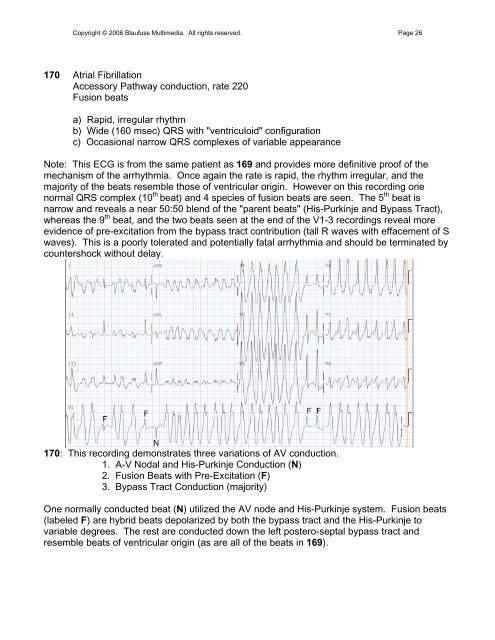002 Sinus Rhythm, atrial rate 90 Mobitz II - Blaufuss Multimedia
002 Sinus Rhythm, atrial rate 90 Mobitz II - Blaufuss Multimedia
002 Sinus Rhythm, atrial rate 90 Mobitz II - Blaufuss Multimedia
Create successful ePaper yourself
Turn your PDF publications into a flip-book with our unique Google optimized e-Paper software.
Copyright © 2006 <strong>Blaufuss</strong> <strong>Multimedia</strong>. All rights reserved. Page 26<br />
170 Atrial Fibrillation<br />
Accessory Pathway conduction, <strong>rate</strong> 220<br />
Fusion beats<br />
a) Rapid, irregular rhythm<br />
b) Wide (160 msec) QRS with "ventriculoid" configuration<br />
c) Occasional narrow QRS complexes of variable appearance<br />
Note: This ECG is from the same patient as 169 and provides more definitive proof of the<br />
mechanism of the arrhythmia. Once again the <strong>rate</strong> is rapid, the rhythm irregular, and the<br />
majority of the beats resemble those of ventricular origin. However on this recording one<br />
normal QRS complex (10 th beat) and 4 species of fusion beats are seen. The 5 th beat is<br />
narrow and reveals a near 50:50 blend of the "parent beats" (His-Purkinje and Bypass Tract),<br />
whereas the 9 th beat, and the two beats seen at the end of the V1-3 recordings reveal more<br />
evidence of pre-excitation from the bypass tract contribution (tall R waves with effacement of S<br />
waves). This is a poorly tole<strong>rate</strong>d and potentially fatal arrhythmia and should be terminated by<br />
countershock without delay.<br />
170: This recording demonst<strong>rate</strong>s three variations of AV conduction.<br />
1. A-V Nodal and His-Purkinje Conduction (N)<br />
2. Fusion Beats with Pre-Excitation (F)<br />
3. Bypass Tract Conduction (majority)<br />
One normally conducted beat (N) utilized the AV node and His-Purkinje system. Fusion beats<br />
(labeled F) are hybrid beats depolarized by both the bypass tract and the His-Purkinje to<br />
variable degrees. The rest are conducted down the left postero-septal bypass tract and<br />
resemble beats of ventricular origin (as are all of the beats in 169).


